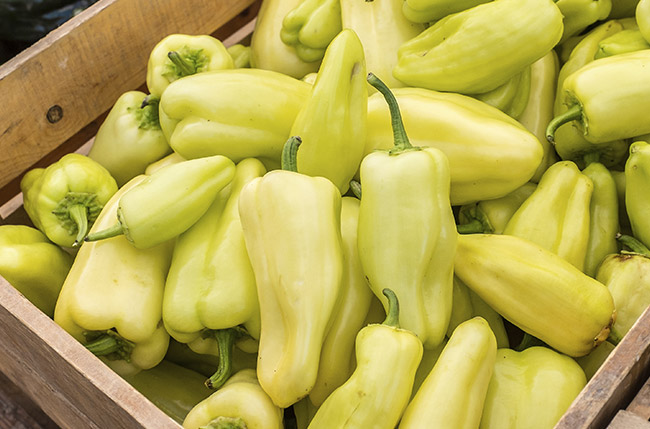
The Caribe (pronounced cah-REE-bay) is a small, light yellow chile named for the native tribe of the Caribbean islands. They are a variety of yellow wax peppers that originate in the Caribbean, and grew in popularity throughout Central America during the Columbus period. They are known in Spanish as chile guero, or blond chile. The term chile guero refers to several different types of chiles depending on the region. In the north of Mexico, the chile guero is a Caribe, but in central Mexico, it refers to the calaro chile. All yellow wax pepper varieties are very similar, in that they have light yellow, waxy skin and they are generally quite a bit spicier than the jalapeño. Caribes range in heat from a tame 5,000 Scoville units to an intense 15,000. Generally, the spiciness of a pepper can be determined by its shape and size. The smaller and skinnier a Caribe is, the spicier it is likely to be. This is not always true, but often times, smaller peppers have a higher concentration of capsaicin and will be spicier.
Caribe chiles can be used in any application that calls for jalapeños or Fresnos, especially when a little more heat is desired. Mole and chili are popular applications for the Caribe pepper. Other great uses include salsa, spicy cornbread, and it can even be used to spice up ice cream and sherbet. Fresh Caribes can bring some heat to soups, salads and casseroles. Caribes also lend themselves to pickling, and can often be found canned. They are sometimes found dried and crushed, especially in specialty spice shops.
When selecting Caribe chiles, pick ones with smooth, firm skin with a waxy sheen. Store Caribes either in the refrigerator for about one week. When the pepper becomes wrinkly and soft to the touch, it is no longer good and should be thrown away. When preparing Caribes, first remove the stem by slicing off the cap of the pepper. If less heat is desired, remove the seeds and membranes from the peppers before using the pepper. To do this, slice the pepper lengthwise, and then scrape out the membranes and seeds with a spoon and discard. It is always important to remember to thoroughly wash your hands after working with spicy peppers before touching your eyes, face or other sensitive body parts, as the oils from the pepper can cause serious irritation. Further, it is advisable that, when dealing with peppers that are spicier than jalapeños to wear disposable latex gloves.


 BACK TO PRODUCTS
BACK TO PRODUCTS